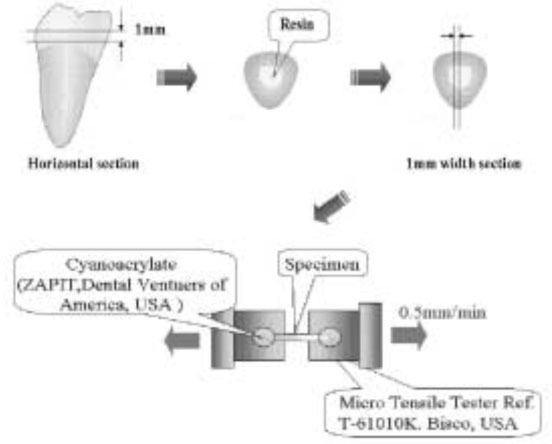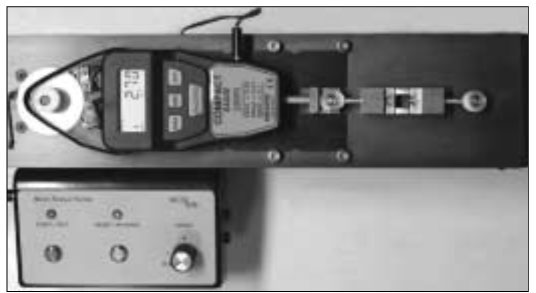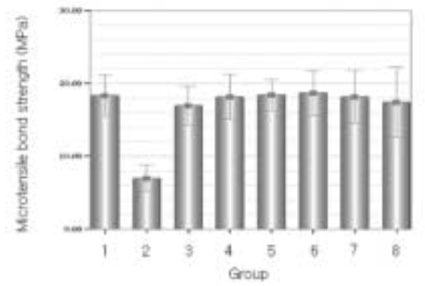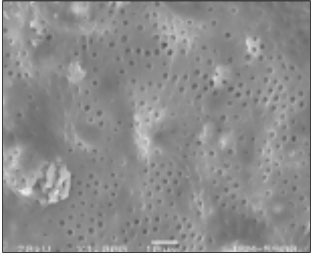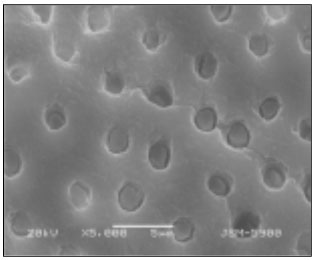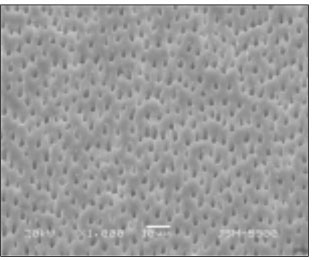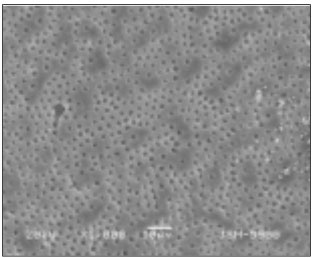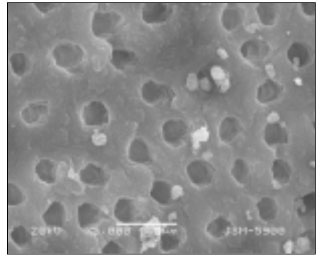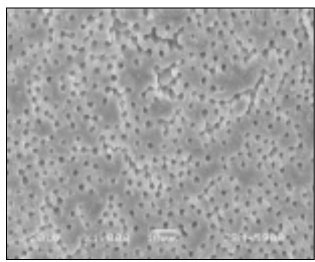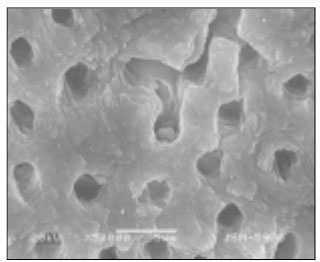J Korean Acad Conserv Dent.
2008 Nov;33(6):545-552. 10.5395/JKACD.2008.33.6.545.
Influence of Sodium Ascorbate on Microtensile Bond Strengths to Pulp Chamber Dentin treated with NaOCl
- Affiliations
-
- 1Department of Conservative Dentistry, School of Dentistry, Chonbuk National University, Korea. mkyou102@hanmail.net
- KMID: 1428465
- DOI: http://doi.org/10.5395/JKACD.2008.33.6.545
Abstract
- The purpose of this study was to evaluate the influence of sodium ascorbate on microtensile bond strengths of total-etching adhesive system to pulp chamber dentin treated with NaOCl. Pulp chambers of extracted human non-caries permanent molars were treated as follows: group 1, with 0.9% NaCl; group 2, with 5.25% NaOCl; group 3, with 5.25% NaOCl and 10% sodium ascorbate for 1min; group 4, with 5.25% NaOCl and 10% sodium ascorbate for 1 min and 10ml of water; group 5, with 5.25% NaOCl and 10% sodium ascorbate for 5 min; group 6, with 5.25% NaOCl and 10% sodium ascorbate for 5 min and 10ml of water; group 7, with 5.25% NaOCl and 10% sodium ascorbate for 10 min; group 8, with 5.25% NaOCl and 10% sodium ascorbate for 10 min and 10ml of water. Treated specimens were dried, bonded with a total-etching adhesive system (Single bond), restored with a composite resin(Z250) and kept for 24h at 100% humidity to measure the microtensile bond strength. NaOCl-treated group (group 2) demonstrated significantly lower strength than the other groups. No significant difference in microtensile bond strengths was found between NaCl-treated group (group 1) and sodium ascorbate-treated groups (group 3-8). The results of this study indicated that dentin treated with NaOCl reduced the microtensile bond strength of Single bond. Application of 10% sodium ascorbate restored the bond strength of Single bond on NaOCl-treated dentin. Application time of sodium ascorbate did not have a significant effect.
Keyword
MeSH Terms
Figure
Cited by 1 articles
-
Changes in µ-TBS to pulp chamber dentin after the application of NaOCl & reversal effect by using sodium ascorbate
Su-Mi Kwon, Tae-Gun Kim, Mi-Kyung Yu, Kwang-Won Lee
J Korean Acad Conserv Dent. 2009;34(6):515-525. doi: 10.5395/JKACD.2009.34.6.515.
Reference
-
1. Gutmann JL. The dentine-root complex : anatomic and biologic considerations in restoring endodontically treated teeth. J Prosthet Dent. 1992. 67:458–467.
Article2. Wagnild GW, Mueller KI. Cohen S, Burns RC, editors. Restoration of endodontically treated tooth. Pathways of the pulp. 1994. ed 7. St. Louis: Mosby;691–717.3. Ray HA, Trope M. Periapical status of endodontically treated teeth in relation to the technical qualty of the root filling and the coronal restoration. Int Endod J. 1995. 28:12–18.
Article4. Ausiello P, De Gee AJ, Rengo S, Davidson CL. Fracture resistance of endodontically-treated premolars adhesively restored. Am J Dent. 1997. 10:237–241.5. Hernandez R, Bader S, Boston D, Trope M. Resistance to fracture of endodontically treated premolars restored with new generation dentine bonding systems. Int Endod J. 1994. 27:281–284.
Article6. Belli S, Zhang Y, Pereira PN, Pashley DH. Adhesive sealing of the pulp chamber. J Endod. 2001. 27:521–526.
Article7. Lim YA, Yoo YD, Lee YK, Lee SJ, Im MK. The Effect of Smear Layer Removal and Position of Dentin on Shear Bond Properties of Dentin Bonding Systems to Internal Cervical Dentin. J Korean Acad Conserv Dent. 1999. 24:465–472.8. Cho JY, Jin MU, Kim YK, Kim SK. The Influence of AH-26 and Zinc Oxide-Eugenol Root Canal Sealer on the Shear Bond Strength of Composite Resin to Dentin. J Korean Acad Conserv Dent. 2006. 31:147–152.
Article9. Nikaido T, Takano Y, Sasafuchi Y, Burrow MF, Tagami J. Bond strength to endodontically-treated teeth. Am J Dent. 1999. 12:177–180.10. Lai SC, Mak YF, Cheung GS, Osorio R, Toledano M, Carvalho RM, Tay FR, Pashley DH. Reversal of compromised bonding to oxidized etched dentin. J Dent Res. 2001. 80(10):1919–1924.
Article11. Morris MD, Lee KW, Agee KA, Bouillaguet S, Pashley DH. Effects of sodium hypochlorite and RC-Prep on bond strengths of resin cement to endodontic surfaces. J Endod. 2001. 27(12):753–757.
Article12. Vongphan N, Senawongse1 P, Somsiri W, Harnirattisai C. Effects of sodium ascorbate on microtensile bond strength of total-etching adhesive system to NaOCl treated dentine. J Dent. 2005. 33(8):689–695.
Article13. Rueggeberg FA, Margeson DH. The effect of oxygen inhibition on an unfilled/filled composite system. J Dent Res. 1990. 69:1652–1658.
Article14. Weston CH, Ito S, Wadgaonkar B, Pashley DH. Effects of time and concentration of sodium ascorbate on reversal of NaOCl-induced reduction in bond strengths. J Endod. 2007. 33(7):879–881.
Article15. Gutteridge JM. Biological origin of free radicals, and mechanisms of antioxidant protection. Chem Biol Interact. 1994. 91:133–140.
Article16. VanDuijn MM, Tijssen K, VanSteveninck J, Van Den Broek PJ, Van Der Zee J. Erythrocytes reduce extracellular ascorbate free radicals using intracellular ascorbate as an electron donor. J Biol Chem. 2000. 275:27720–27725.
Article17. Torneck CD, Titley KC, Smith DC, Adibfar A. Adhesion of light-cured composite resin to bleached and unbleached bovine dentin. Endod Dent Traumatol. 1990. 6:97–103.
Article18. Inai N, Kanemura N, Tagami J, Watanabe LG, Marshall SJ, Marshall GW. Adhesion between collagen depleted dentin and dentin adhesives. Am J Dent. 1998. 11:123–127.19. Pioch T, Kobaslija S, Schagen B, Gotz H. Interfacial micromorphology and tensile bond strength of dentin bonding systems after NaOCl treatment. J Adhes Dent. 1999. 1:135–142.20. Frankenberger R, Kramer N, Oberschachtsiek H, Petschelt A. Dentin bond strength and marginal adaption after NaOCl pre-treatment. Oper Dent. 2000. 25:40–45.21. Prati C, Chersoni S, Pashly DH. Effect of removal of surface collagen fibrils on resin-dentin bonding. Dent Mater. 1999. 15:323–331.
Article22. Rose RC, Bode AM. Biology of free radical scavengers : an evaluation of ascorbate. FASEB J. 1993. 7:1135–1142.
- Full Text Links
- Actions
-
Cited
- CITED
-
- Close
- Share
- Similar articles
-
- Changes in micro-TBS to pulp chamber dentin after the application of NaOCl & reversal effect by using sodium ascorbate
- The effect of concentration and application time of hydrogen peroxide on the microtensile bond strength of resin restorations to the dentin at different depths
- Effects of applying antioxidants on bond strength of bleached bovine dentin
- Pull-out bond strength of a self-adhesive resin cement to NaOCl-treated root dentin: effect of antioxidizing agents
- Microtensile bonding of resin fiber reinforced post to radicular dentin using resin cement

